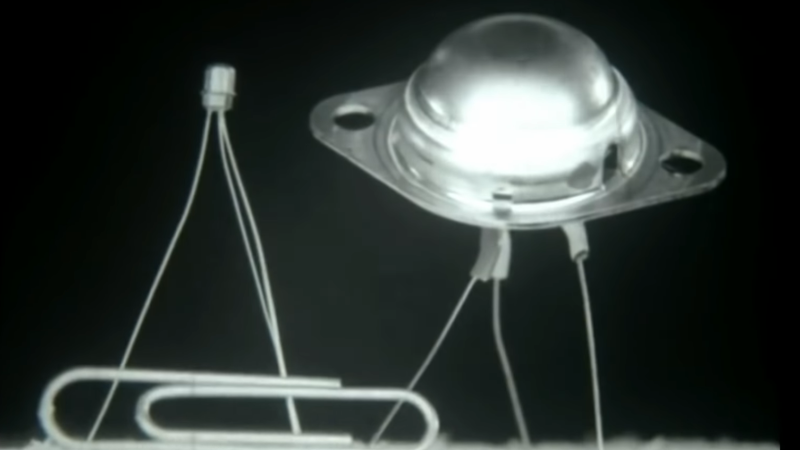There was a time when all major corporations maintained film production departments to crank out public relations pieces, and the electronic industry was no exception. Indeed, in the sea-change years of the mid-20th century, corporate propaganda like this look at Philco transistor manufacturing was more important than ever, as companies tried to pivot from vacuum tubes to solid-state components, and needed to build the consumer electronics markets that would power the next few decades of rapid growth.
The film below was produced in 1957, just a decade since the invention of the transistor and only a few years since Philco invented the surface-barrier transistor, the technology behind the components. It shows them being made in their “completely air-conditioned, modern plant” in Pennsylvania. The semiconductor was germanium, of course — the narrator only refers to “silly-con” transistors once near the end of the film — but the SBT process, with opposing jets of indium sulfate electrolyte being used to both etch the germanium chip and form the collector and emitter of the transistor, is a fascinating process, and these transistors were quite the advance back in the day. It’s interesting, too, to watch the casual nature of the manufacturing process — no clean rooms, no hair nets, and only a lab coat and “vacuum welcome mats” to keep things reasonably clean.
As in most such corporate productions, superlatives abound, so be prepared for quite a bit of hyperbole on the part of the Mid-Atlantic-accented narrator. And we noticed a bit of a whoopsie near the end, when he proudly intoned that Philco transistors would be aboard the “first Earth satellite.” They were used in the radio of Explorer 1, but the Russians had other ideas about who was going to be first.
And speaking of propaganda, don’t forget that at around this time, vacuum tube companies were fighting for their lives too. That’s where something like this designer’s guide to the evils of transistors came from.















is this a German V1 missile at 12:04?
Oops regarding reporting the comment, fingers too quick for the brain.
As to the rocket in question – it looks more like a redstone, which would have been the current army rocket tech. The V2 had a fatter profile
Didn’t far enough in the clip. Definitely not a V2, perhaps a predecessor to the Snark?
Maybe yes, maybe not quite https://en.wikipedia.org/wiki/Republic-Ford_JB-2
Questionable example to pick anyway, since early V-1 versions just had the electromechanical guidance run by gyros and prop driven odometers, later versions got some radio course correction happening, but that woulda been tubes/valves.
See this series, too, about Japan’s first Germanium transistors.
Documentary “A video history of Japan’s electronic industry”:
https://www.eevblog.com/forum/chat/fun-for-nerds/msg3297026/#msg3297026
:o)
That’s how my first OC70 was made, when I bought it in the mid-1960s. It must have been expensive at that time, as all I could afford as a school boy was to buy it as a used one at the local radio service.
I’m considering playing with OCP71s by the way ;-) Each costs a few dollars now… but their price is skyrocketting because the new-old-stock supply is drying and speculators are now playing their game…
An OCP71 is just a plastic encapsulated OC71 with the black paint scratched off. The OC70 / 71 /72 were inherently light sensitive and hence the black paint. I not sure but the paint may be lead based from that era.
This is a urban legend.
OCP71s were binned OC70/71s in unpainted glass (not scratched).
The filling is also different : OCP71 is transparend grease, while OC71 is translucent/diffusing.
As a proof : you can clearly see the inside of OCP71, while a scratched OC70 will not let you see much.
I read that on a web page and verified it recently :-)
I don’t remember the number series anymore or which was which.
I do however remember getting OC7x’s and scratching the black paint (and red dot) off and using them as opto-sensors. Though it was a long time ago now.
Proper old skool OC71’s had an aluminium can over the glass envelope.
I tried gently removing top of BC107 transistor can with a file once, and then filling the rest with clear glue (as recommended in a magazine). It worked fine as DIY phototransistor.
Related, for context : https://www.youtube.com/watch?v=waca90Fzetk
And of course, the Wikipedia article : https://en.wikipedia.org/wiki/Philco
And all the HaD fanboys : https://hackaday.io/project/58287-bipolar-dudes
“It’s interesting, too, to watch the casual nature of the manufacturing process — no clean rooms, no hair nets, and only a lab coat and “vacuum welcome mats” to keep things reasonably clean.”
Sounds like the commodore chip making process.
https://youtu.be/xu8Fi0tC9IA
Etching accuracy to 1/10,000th of an inch. Makes these 5nm chips awesome by comparison!
That clip is rather militaristic and the voice so annoying, I had to switch over to subtitles.
Except from the technical details…
I was a CK721 person in 1949 :-)